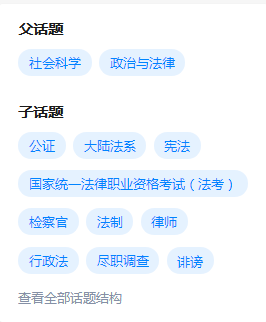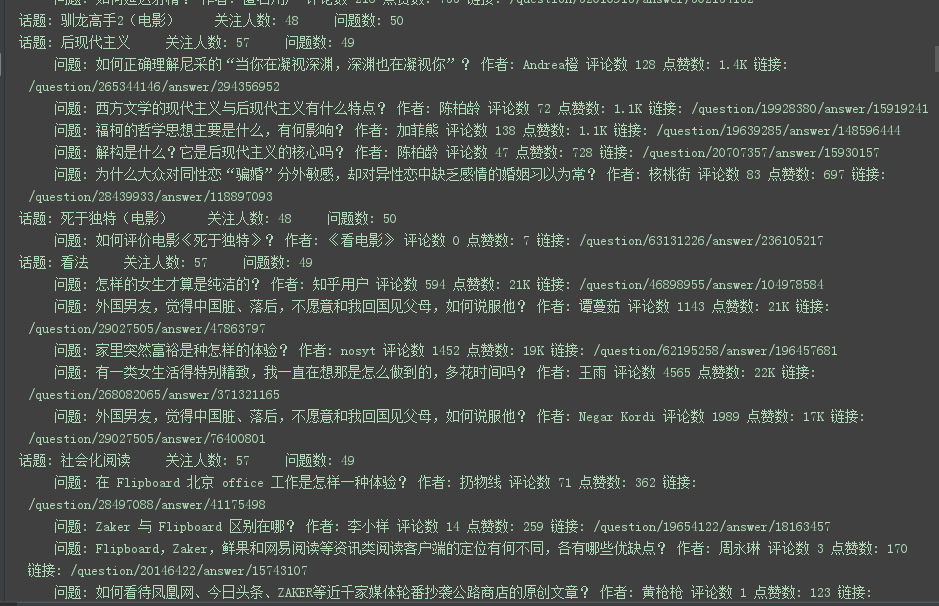因为平时喜欢上知乎,发现其话题是一个有向无环图(自己介绍说得),一级一级往上最后到根话题,所以我就想尝试从根话题一级一级往下将其全部内容爬取。最后实践过程中发现自己想多了..有以下三个问题:
1.数据量巨大,单台电脑能力肯定不够。我这里只抓取了话题结构和话题对应的单个页面(不翻页)的一些呈现信息,没有抓取具体问题回答的内容。
2.如果直接连续抓取,没多少次就会被知乎检测到异常,这里使用代理ip可以解决。
3.最麻烦的是要查看所有话题结构必须要登录(如下图示例显示的子话题是可以抓到的,但是点击查看全部话题结构就需要登录),一旦登录就不可能连续抓取,除非能搞到很多账号,而且还需要破解验证等问题。我这块目前只是从根话题抓取直接显示出来的子话题,所以抓取到的话题数量和实际差的很远。后面计划使用一个其他方法抓取(看这里)

存储由于key-value型很适合这里,所以我使用的是redis数据库,而且很快。一共有四张key-value表,zhTopicName保存话题名称(key)-子话题id(value,后同),zhTopicTree保存话题的结构有向无环图(邻接链表法,id-[子话题id...]),zhTopicMessage保存话题id-(关注人数,问题数),zhTopicQuestions保存话题id-[(问题名称,作者,评论数,点赞数,链接)...]
参考代码如下:
1 # -*- coding: UTF-8 -*- 2 3 from bs4 import BeautifulSoup 4 import requests 5 import random 6 import redis 7 import time 8 import json 9 10 # 子话题目录id获取接口url,当前初始根话题id为19776749 11 CHILDREN_URL = 'https://www.zhihu.com/api/v3/topics/%u/children' 12 13 # 知乎精华url 14 TOP_ANSWERS_URL = 'https://www.zhihu.com/topic/%u/top-answers' 15 16 # 请求头 17 HEADERS = {'User-Agent': 'Mozilla/5.0 (Windows NT 6.1; Win64; x64) AppleWebKit/537.36 18 16 (KHTML, like Gecko) Chrome/67.0.3396.99 Safari/537.36'} 19 20 # 代理ip,这里示例放了一个,自己可以在网上找些补充下 21 PROXIES_LIST = [ 22 {"http": "218.14.227.198:3124"}, 23 ] 24 25 pool = redis.ConnectionPool(host='localhost', port=6379, db=0) 26 27 r = redis.Redis(connection_pool=pool) 28 29 s = requests.session() 30 31 32 def crawl_message(uid): 33 try: 34 req = s.get(url=TOP_ANSWERS_URL % int(uid), headers=HEADERS, proxies=random.choice(PROXIES_LIST)).text 35 except Exception as e: 36 raise e 37 bf = BeautifulSoup(req, 'html.parser') 38 strong = bf.find_all('strong', class_='NumberBoard-itemValue') 39 # 0为关注人数,1为问题数 40 try: 41 r.hset('zhTopicMessage', uid, (strong[0].get('title'), strong[1].get('title'))) 42 except Exception as ex: 43 print(uid, ex) 44 return 45 items = bf.find_all('div', class_='ContentItem AnswerItem') 46 tqs = [] 47 for t in items: 48 # 问题、作者、评论数、点赞数、链接 49 tqs.append((eval(t.get('data-zop'))['title'], eval(t.get('data-zop'))['authorName'], 50 t.find(itemprop='commentCount').get('content'), 51 t.find('button', class_="Button VoteButton VoteButton--up").contents[-1], 52 t.find('a').get('href'))) 53 r.hset('zhTopicQuestions', uid, tqs) 54 time.sleep(0.1) 55 56 57 # 获取话题的那个有向无环图以及其名称与id的对应关系并入库 58 def crawl_topic(): 59 while len(crawl_topic.zhTopic) > 0: 60 try: 61 data = 62 json.loads( 63 s.get(url=CHILDREN_URL % int(crawl_topic.zhTopic[0]), headers=HEADERS, 64 proxies=random.choice(PROXIES_LIST)).text)[ 65 'data'] 66 except Exception as ex: 67 raise ex 68 if not data: # 已经到叶子话题返回 69 crawl_topic.zhTopic.pop(0) 70 continue 71 ids = [] 72 for m in data: 73 nid = m['id'] 74 ids.append(nid) 75 crawl_topic.zhTopic.append(nid) 76 r.hset('zhTopicName', m['name'], nid) 77 r.hset('zhTopicTree', nid, ids) 78 crawl_topic.zhTopic.pop(0) 79 80 81 def start_crawl(): 82 # 19776749为当前知乎根话题id 83 # 这里构造一个id队列避免使用递归 84 crawl_topic.zhTopic = [19776749] 85 r.hset('zhTopicName', '「根话题」', 19776749) 86 crawl_topic() 87 ids = r.hvals('zhTopicName') 88 for tid in ids: 89 crawl_message(tid) 90 91 92 def result_display(): 93 try: 94 for tnm in r.hkeys('zhTopicName'): 95 tid = r.hget('zhTopicName', tnm) 96 print('话题:', tnm.decode(), ' 关注人数:', tid[1], ' 问题数:', tid[0]) 97 for e in eval(r.hget('zhTopicQuestions', tid).decode()): 98 print(' ', '问题:', e[0], '作者:', e[1], '评论数', e[2], '点赞数:', e[3], '链接:', e[4]) 99 except Exception as ex: 100 print(ex) 101 102 103 if __name__ == '__main__': 104 start_crawl() 105 result_display()
在我本机测试一共运行了5个小时左右获取了1万3千多个话题(如上问题3所述,远少于实际话题数,估计不到十分之一),每个话题不到5条精华问题(页面直接展示几条就抓几条,没有翻页)。下面展示下运行结果:

最后按网上流行那种话题关注人数多少对应字体大小画张图展示下(我也是现学现卖,仅供参考:))
代码如下:
1 import matplotlib.pyplot as plt 2 from matplotlib import colors as mcolors 3 import numpy as np 4 import random 5 import redis 6 7 pool = redis.ConnectionPool(host='localhost', port=6379, db=0) 8 9 r = redis.Redis(connection_pool=pool) 10 11 followers = [] 12 for tnm in r.hkeys('zhTopicName'): 13 tid = r.hget('zhTopicName', tnm) 14 msg = r.hget('zhTopicMessage', tid) 15 if msg: 16 followers.append((tnm.decode(), int(eval(msg)[0]))) 17 # 按关注人数取前300的话题 18 hotTopics = sorted(followers, key=lambda follower: follower[1], reverse=True)[0:300] 19 20 plt.figure(figsize=(10, 6.18)) 21 plt.setp(plt.gca(), frame_on=False, xticks=(), yticks=()) 22 plt.axis([0, 100, 0, 100]) 23 plt.rcParams['font.sans-serif'] = ['SimHei'] 24 25 randC = np.linspace(-20, 100, 300) 26 27 colors = dict(mcolors.BASE_COLORS, **mcolors.CSS4_COLORS) 28 by_hsv = sorted((tuple(mcolors.rgb_to_hsv(mcolors.to_rgba(color)[:3])), name) 29 for name, color in colors.items()) 30 sorted_names = [name for hsv, name in by_hsv] 31 random.shuffle(sorted_names) 32 33 random.shuffle(randC) 34 35 rankings = 0 36 for topic in hotTopics: 37 plt.text(randC[rankings], randC[299 - rankings], topic[0], fontsize=(300 - rankings) / 10 + 10, 38 rotation=random.randint(-30, 30), style='italic', alpha=0.75, 39 color=sorted_names[rankings % len(sorted_names)]) 40 rankings = rankings + 1 41 42 plt.show()
运行结果:
